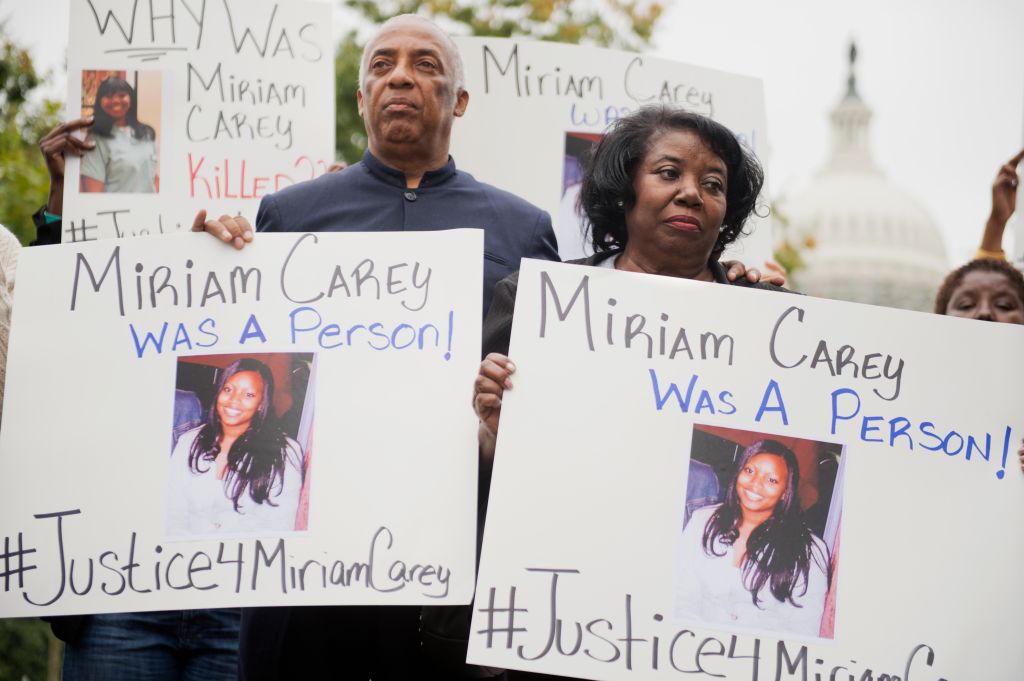Valarie and Miriam Carey’s late mother, Idella Carey, at a protest for her daughter in Brooklyn Source: Tom Williams / Getty
“Miriam was killed 11 years ago this month, but I still haven’t figured out how to navigate my feelings. It’s still too hard.” This was how Valerie Carey began a quiet discussion about her little sister with me on Tuesday for NewsOne.
Thursday, Oct. 3, 2013, was a hot, hard fall afternoon in Washington, D.C., when Valarie’s sister, Miriam Carey, arrived in the nation’s capital. It was her day off. For years, the 34-year-old dental hygienist held down two different jobs in two different dental offices. One of them was in the Bronx, the other in Ardsley, NY, 24 miles from Stamford, Conn., where she bought a condo and set down roots.
Speaking to the Washington Post in 2014, Barbara Nicholson, the manager who hired Miriam to work at the Ardsley dental office, said Miriam wasn’t only one of the best, most professional hygienists she’d ever brought on, but the nicest. Like Valarie and the rest of Miriam’s family, she still cannot make sense of what happened to her in October of 2013.
October 3, 2013
Miriam left her home the morning of the 3rd and drove to D.C. in her two-door black Infiniti G37. Safely and visibly ensconced in a car seat in the back, was her 14-month-old baby girl. Miriam Carey was a first-time and brand-new mother.
At 2:12 that afternoon, she entered a White House checkpoint.
”Back then, it was a soft checkpoint,” Valarie said, meaning it was unmarked. “I’m sure she didn’t realize it until it was too late,”
After a moment, Valarie continues, “I can’t imagine how scared my sister was. These were armed men, Miriam had her baby with her. One agent who confronted her aggressively turned out to be an off-duty, out-of-uniform officer. How could she know he wasn’t a crazy man attacking her and her daughter?”
“But,” she points out, “this is the man who tried to barricade Miriam in the perimeter and, at one point, threw himself in front of Miriam’s car. That’s totally against protocol,” Valarie, a retired NYPD sergeant, says.
Barbara Nicholson also thought Miriam had to have been terrified. In 2014, she told the Post, “We all speculated that she was trying to get her child out of danger when she was confronted with people with guns…”
And thinking about those split seconds, who, traveling alone with their baby, wouldn’t have been stunned, afraid of the armed men at the unmarked checkpoint? Where Miriam encountered them, the White House could not even be seen.
Source: New York Daily News / Getty
Mother Miriam
Miriam Carey was a loving and doting mother, Valarie shares, her voice barely a whisper at this point, but nevertheless firm. She begins discussing the way her sister’s prior struggle with mental health was used to justify the police killing her. But Miriam had been doing remarkably better since she’d separated from her daughter’s father earlier in 2013. Valarie remembers Miriam saying that he hadn’t even tried to see the baby since before the summer of 2013.
Colleagues and relatives remember there being nothing out of the ordinary with Miriam just before she left for D.C. She’d told several she’d see them that weekend or back in the office on Monday.
Of all the potential horrible scenarios one might fear when a woman gets into her car with her infant, no family member, friend, or colleague of Miriam’s ever imagined, nor could have, what actually occurred: Miriam being publicly shot to death by law enforcement as her baby looked on.
But that’s what happened in the roughly seven minutes that immediately followed 2:12 p.m. when Miriam pulled into the checkpoint, left, and drove to the 100 block of Constitution Avenue near the Capitol.
Contrary to media reports, Miriam did not lead a high-speed car chase as originally reported by police and still widely repeated. Miriam, even being followed, drove between 19 and 40 mph before being forced to a stop by Secret Service and Capitol Police officers who’d been firing at her as she drove and fired upon her when she was stopped.
In total, they unleashed 26 bullets into the car Miriam and her baby were trapped inside. Five of them pierced Miriam’s body, one through the back of her head.
Valarie Carey Source: Valarie Carey / Valarie Carey
No one, Valarie says, understands how none of those shots hit Miriam’s baby. “We’re simply and deeply grateful,” she says.
But like all those who loved her sister, Valarie remains shattered by the five bullets that hit Miriam. And she’s haunted by the questions law enforcement still refuses to answer.
Silence = Death
Lumumba Bandele, a lifelong and deeply respected organizer who lives in Brooklyn with his family, doubted the events surrounding Miriam Carey’s death from the beginning.
Bandele, a child of the East–an African-centered political movement that was started in the 1970s. It gave birth to a number of social justice and service organizations and schools that still thrive today—was mentored by and worked for revered Young Lords member, the late Richie Perez.
“Unlike organizations that identify primarily as ‘leftist’ and don’t center a race analysis,” Bandele, speaking with me Tuesday, said, “Richie taught us to fight for ending police violence by centering victims, surviving families and their truths.” Most of those victims and surviving families were, unsurprisingly, Black or Latino.
Using what he’d learned from Richie, who died out of season in March of 2004, Bandele and colleagues in the Malcolm X Grassroots Movement, were key in ending New York’s Stop and Frisk policy that targeted and harmed thousands and thousands of young Black and Latino people. They were also critical in dismantling the notorious Street Crimes Unit, which indicted Mayor, Eric Adams, just reestablished.
Like the federal agents who trained their weapons on Miriam and killed her, Bandele says the Street Crimes Unit operated in opacity. “It wasn’t accountable to any precinct,” he explains about the plainclothes officers of the unit. “They didn’t have to answer to anyone, least of all the communities they terrorized,”
Eric Sanders, the civil rights attorney who represents the Carey family–and who also was once a police officer–said to the Post three years ago that “…there’s a lack of transparency in policing in general [but when it comes to law enforcement that’s part of] the federal government …[the rules around transparency]…. keep their whole agencies operating in secrecy, whether it’s the Capitol Police [or] the Secret Service…”
To this day–and along with the police railroad recordings from Oct. 3, and other critical details, not the least of which are the names of the officers who participated in hunting Miriam down and the two who killed her—remain sealed.
At the end of our conversation, Bandele reminded me that New York City’s Street Crimes Unit had a motto: We own the night.
Secret Service and Capitol Area police never needed to make such a declaration.
What remains
Source: Viviane Moos / Getty
To this day, law enforcement’s account of what happened on Oct. 3, 2013, is, at best, questionable. At worst, it’s a jumble of flat-out lies.
But that didn’t stop most mainstream and generally respected media outlets, including but in no way limited to, CNN, from framing Miriam’s story through a largely unchallenged law enforcement perspective.
David Montgomery of the Washington Post, whose work I’ve been referencing throughout this writing, was different. Valarie says he was the first–and for a long time, singular–mainstream journalist who chose to investigate what really happened to her sister.
Miriam was killed 10 months before the public outrage in response to racist police violence reached its heights in the first quarter of the 21st century. That moment didn’t erupt until young people in Ferguson, Missouri erupted, following another public police killing of another unarmed Black person, teenager Michael Brown, on August 9, 2014.
To this day, the questions surrounding Miriam Carey’s death at the hands of law enforcement are lengthy and, in their persistence, somehow, especially chilling.
These are just a few:
Why did police abandon protocol and shoot at a moving vehicle, particularly one that had a baby in the back of it?
Why did police risk turning a car into an unguided missile that threatened uninvolved civilians by killing its driver?
What was their need—if they were truthful about their perceptions of Miriam—to allow false narratives about the events of the day to continue to be repeated?
Why try to block a woman into the very perimeter they were there to protect, and why wasn’t the perimeter clearly marked? Why, knowing it wasn’t, were they unusually aggressive toward an unarmed woman traveling with a baby?
Why keep the shooters’ names private if they legitimately believed Miriam may have been about to commit an act of terrorism?
Why draw guns on Miriam in the first place? That alone was a rarity–and one not undertaken the month prior when a man armed with a knife actually jumped a fence and ran into the executive mansion. He was tackled.
Why was law enforcement’s response to one Black woman and a baby so disproportionately so much greater than the response to thousands of rioters who descended the Capitol on January 6, 2021?
Why not release all the documents relevant to the killing of a mother in front of her child, and why not release the police radio recordings from that day?
And perhaps superseding all other questions are these two: When will Miriam’s family finally know justice?
When will we be able to stop having to #SayHerName?
See More:
‘Say Her Name’: Janelle Monáe’s New Song Draws Attention To Black Girls And Women Killed By Police
Important Reads To Help You Understand The Problem Of Police Brutality
READ MORE STORIES ON BLACKAMERICAWEB.COM:
Miriam Carey Was Killed By Police In October 2013: We Still Have QuestionsFinancial Literacy Tips For Building Black Generational Wealth In 2025Sybil Wilkes Exclusive: King McClure, Jared Butler And Heart Experts Talk Hypertrophic Cardiomyopathy (HCM)
HEAD TO THE BLACKAMERICAWEB.COM HOMEPAGE






